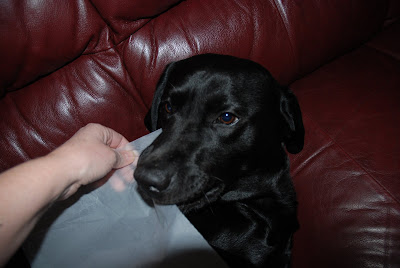 For those of you who are saying to me and yourself, "but I can't draw, whimper, whimper, whine!" Yes you can!
For those of you who are saying to me and yourself, "but I can't draw, whimper, whimper, whine!" Yes you can!There are many ways to get your subject down on paper. Here are some of the ways:
1.) You can trace it. Usually you will want to actually work from a photo and not the live model as I have pictured here. The photo usually doesn't try to eat your work as it progresses. If you are going to do a direct tracing you should work from at least an 8x10 enlargement of your subject. Otherwise you will have a problem getting those wee itty bitty details I love so much as that make a painting photo-realistic.
If tracing is your method then go to your local art store and purchase a good quality tracing paper. The cheaper stuff is more opaque. You can use a light box or bright window to place your photo on to make it easier to trace.
2.) You can use a grid. This is a whole other method that is excellent, but time consuming to describe. If you are interested in this method leave me a comment and I'll explain about creating your grid and how to size the photo to the paper correctly and how to transfer the image. It's actually drawing using lines on your photo and drawing paper as guides. Similarly you can use a "picture plane."
3.) Even the masters used methods of projecting images onto canvasses. You can too by using an opaque projector or slides. If you use this method be aware that distortion is a real problem. You may have a lot of fixin' to do!
4.) My suggestion is just to draw the blasted thing! I concur with my various art instructors in that you must actually draw the image to bring life to it. My coloured pencil instructor would insist upon the long painful drawn out method of drawing the line drawing from scratch in front of her so there was no cheating! It generally took me longer to do a sketch than everyone else, but my paintings usually had more detail than everyone elses. So simple drawing or more complex, drawing it yourself is definately the best method out there!
You can draw from a live model or from a photograph. In coloured pencil work a photo is a wise choice! You will be looking at it for many hours and in much detail. It's hard to do this from a live model. You will continue to use the photo for a reference during the rendering process to assist you in matching colours, lighting, etc. Live models generally don't do well sitting still for 40 to 100 hours and would probably expect something silly like being paid for their work.
If you do work from a photo having a digital photo is better so you can make any small adjustments you may want. They also can be enlarged to larger sizes without loosing quality. You should work from at least an 8x10. You can work from smaller photos, but try not to choose one with a lot of detail if that is the case!
If you do use one of the other above methods you will need to fix any distortion that will occur in transferring the image. You would be surprised at how much distortion there is in your average photograph! You also won't improve your drawing skills if you trace everything! In my case the nude models tend to get a bit miffed If I get to close to their dangly bits with a sharp pencil in an attempt to trace them!
Which ever method you use, you need to get a basic line drawing down on a cheap piece of paper.

2 comments:
The last drawing class I took we did the graph technique. THAT was soooo cool. I may even still have the quarter-done picture in an old portfolio in deep storage.
The time commitment. That's one reason that I might just remain a sketcher or photographer.
Oh, and I was hoping to get The Husband to pose nude.:)
Post a Comment